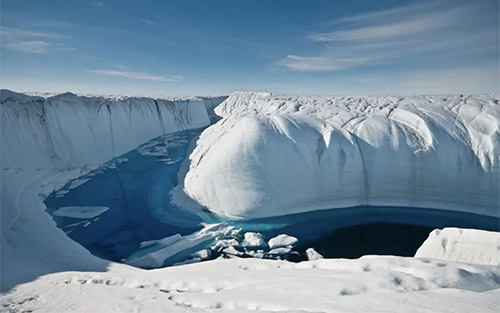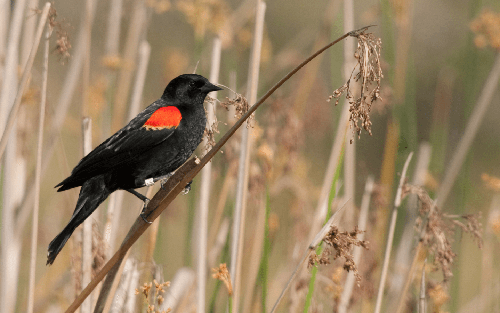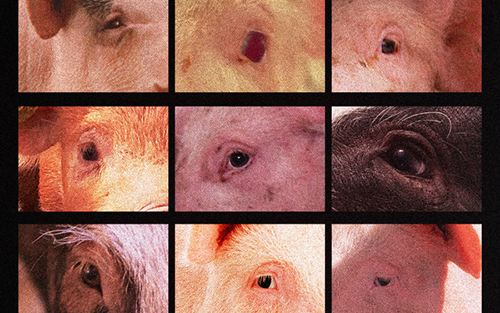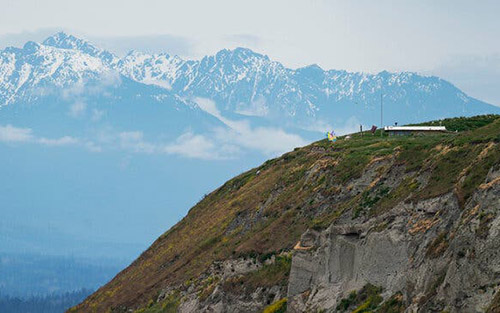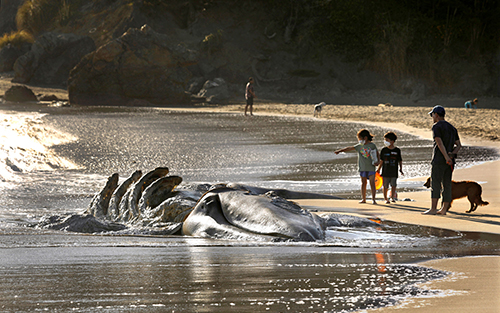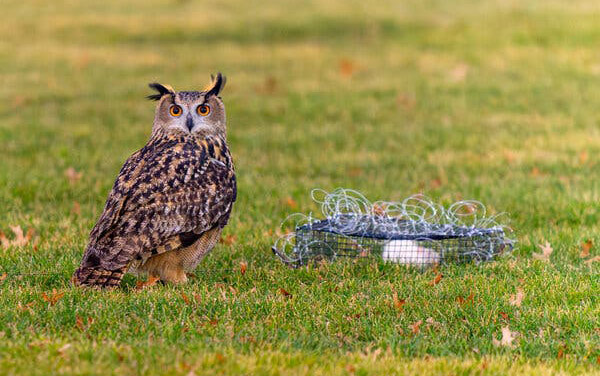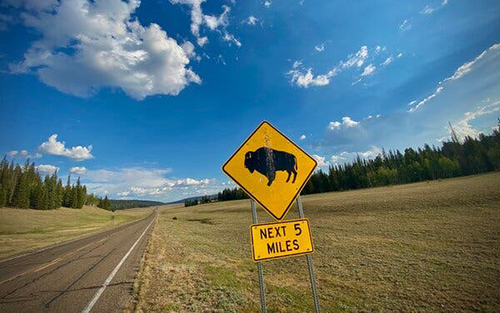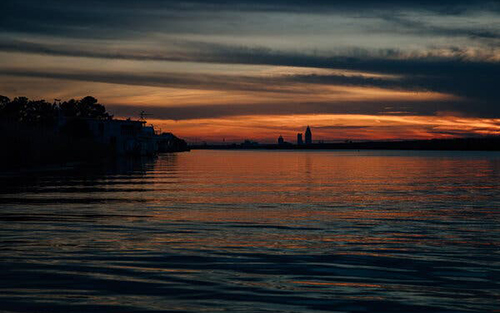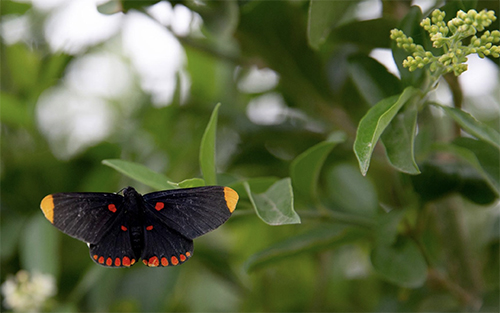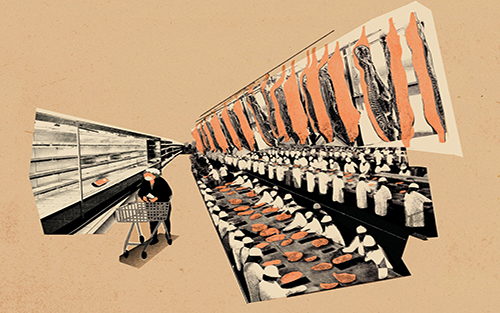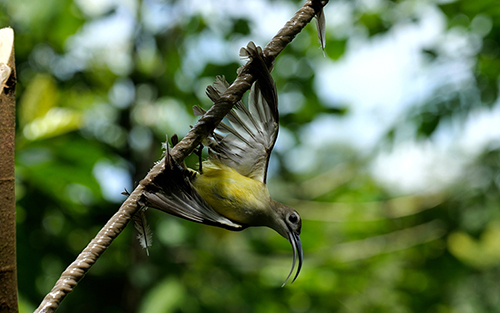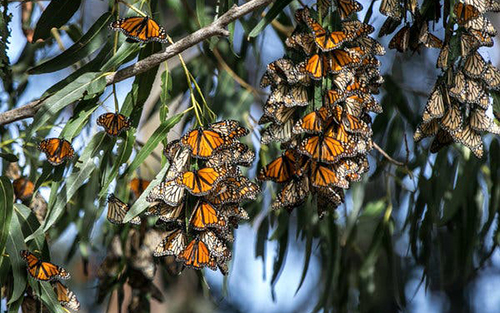Welcome to our news edit of interesting, pertinent articles. We encourage you to read, learn and share.
It Would Block a Key Wildlife Corridor. The barrier, in a remote part of Arizona, would threaten one of the most important remaining animal migration routes on the state’s southern border.
www.nytimes.com/2025/07/31/climate/arizona-border-wall-wildlife-migration-jaguars.htmlNesting often high in the redwoods’ canopy, the marbled murrelet faces new and longstanding risks.
www.nytimes.com/2025/09/23/science/marbled-murrelet-endangered-redwoods"It's a really important reminder that plastic pollution does pose an existential threat to ocean wildlife,"
https://www.bbc.com/news/articlesScientists are concerned that the H5N1 virus could set off another human pandemic. But it is already putting species under pressure in the wild.
www.nytimes.com/2024/12/13/science/bird-flu-h5n1-wildlifeDozens More Species Are Discovered in a Peruvian Jungle
www.nytimes.com/2024/12/20/science/peru-alto-mayo-species-discoveredA marine heat wave in the Pacific Ocean that began a decade ago killed some 4 million common murres in Alaska, researchers say.
www.washingtonpost.com/climate-environment/2024/12/12A century after Upton Sinclair exposed conditions in Chicago stockyards, animal life in USA’s factory farms and slaughterhouses is still gruesome.
https://www.nybooks.com/articles/2024/12/19/reports-from-the-slaughterhouse-fear-factories-scully/?utm_source=nybooks&utm_medium=email&utm_campaign=email-shareA company controlled by Goldman Sachs is helping to lead a lobbying effort by makers of fertilizer linked to “forever chemicals.”
/www.nytimes.com/2024/12/06/climate/sludge-fertilizerWe were in a cataclysmic age of mass extinction and climate instability before the election. Now the climate denier in chief is poised to gut the environmental protections that do exist.
www.nytimes.com/2024/11/18/opinion/climate-endangered-animals-humansThe tallest land animals in the world are declining so precipitously that they should be protected under the United States Endangered Species Act, federal wildlife officials said Wednesday.
\www.nytimes.com/2024/11/20/climate/giraffes-threatenedThinking about raking freshly fallen leaves into a pile? Think again, scientists and naturalists say.
https://www.nytimes.com/2023/10/19/us/raking-leaves.htmlPoultry Giants Cull and Cash In. Big poultry farms have received millions of dollars for their losses. Animal welfare groups contend that aid reinforces inhumane cullings of birds exposed to the virus.
www.nytimes.com/2024/04/02/science/bird-flu-aid-animal-welfareIn Brazil, wildfires have roared across the Pantanal, a maze of rivers, forests and marshlands that sprawl over an area 20 times the size of the Everglades.
www.nytimes.com/2024/08/27/world/americas/pantanal-wildfiresHuman development has led to the destruction of a quarter of a million acres of estuarine habitat around the world over the past 35 years
https://geographical.co.uk/news/study-reveals-extent-of-human-led-destruction-to-estuariesAn enormous overpass in Southern California is “more than just a bridge,” an official said.
www.nytimes.com/2024/07/09/us/california-wildlife-crossingFirefly populations appear to be in decline around the globe. 14 percent of assessed species — including 18 North American species — are at risk of extinction.
www.nytimes.com/2024/06/17/opinion/firefliesTens of millions of farm animals cross state lines every year, traveling in cramped, stressful conditions that can facilitate the spread of disease.
www.nytimes.com/2024/05/20/health/livestock-disease-transportMore than almost anything else we put into our mouths, meat matters. Our appetite for meat is hurting the world.
www.nytimes.com/2024/09/21/climate/lab-grown-meat-futureTo mitigate bird collisions, enforce the Migratory Bird Treaty Act
www.pnas.orgWhat will we lose when Najin and Fatu die?
www.nytimes.com/2021/01/06/magazine/the-last-two-northern-white-rhinos-on-earth“There is no reason to think that in 30 years much of anything will be as it is today,”
www.nytimes.com/2020/12/08/climate/arctic-climate-changeWild cats play vital roles in almost all the environments where they occur. For that reason, aiding their recovery can also help to achieve quantifiable progress on many of our planet’s urgent environmental goals.
www.washingtonpost.com/opinionsWe need Congress and the Biden administration to immediately restore protections for birds with an incidental take permitting program under the Migratory Bird Treaty Act.
www.nrdc.orgWILDLIFE IS DISAPPEARING around the world, in the oceans and on land. The main cause on land is perhaps the most straightforward: Humans are taking over too much of the planet, erasing what was there before.
www.nytimes.com/climate/biodiversity-habitat-loss-climateScientists are unearthing a quiet truth about the woods: Where trees grow, or don’t, depends in part on the quirky decisions of small mammals.
www.nytimes.com/2022/11/25/science/climate-forests-seeds-micePresident Biden has promised to reinstate more than 100 rules and regulations aimed at environmental protection that his predecessor rolled back. It won’t happen overnight.
www.nytimes.com/2021/01/22/climate/biden-environmentScientists warn of ongoing global insect abundance losses and say we lack a full understanding of invertebrate extinction causes and synergies.
news.mongabay.comThe latest update to an important assessment found that populations had declined by an average of 69 percent since 1970. But that might not mean what you think.
www.nytimes.com/2022/10/12/climate/living-planet-index-wiMany crop seeds are coated with toxic insecticides called neonicotinoids, which threaten seed- and insect-eating birds while providing few benefits to crops in most cases.
abcbirds.org/news/epa-pesticide-coated-seed-decision-2022/The Pale-headed Brushfinch was rediscovered in a dry inter-Andean valley in west-central Ecuador almost 25 years ago — following three decades without a record of the species.
abcbirds.org/blog/question-of-habitat/Anthropogenic noise is becoming unbearable for undersea life.
www.nytimes.com/2021/02/04/science/ocean-marine-noise-pollutionEnvironmental destruction and violence threaten one of the world’s most extraordinary insect migrations.
www.newyorker.com/magazineGiven the loss of nearly 3 billion birds in the U.S. and Canada since 1970, American Bird Conservancy (ABC) is encouraging action to help birds survive and thrive. Here are ways to help:
https://abcbirds.orgAn investigator went under cover and brought back disturbing video from a farm growing those famous birds.
www.nytimes.comSturgeon are disappearing from North American rivers where they thrived for millions of years. And the quest to save them is exposing the limits of the Endangered Species Act.
www.nytimes.com/2023/02/02/magazine/they-outlasted-the-dinosaurs-can-they-survive-Gray wolf lost protections last year; a recent hunt that killed at least 216 wolves far exceeded quota.
www.nytimes.com/2021/03/03/us/wisconsin-wolves-killingsJust 50 or so remain, eking it out in the Gulf of Mexico off the Florida coast.
www.nytimes.com/2021/03/06/opinion/discovery-whale-extinctionBison once numbered in the tens of millions in the United States. Now, a nonprofit is working to restore the shortgrass prairie, where the American icons and their ecosystem can thrive again.
www.nytimes.com/2023/01/10/science/bison-prairie-grasslandImmense flocks of sandhill cranes — 15,000 at Wheeler alone — spend winter at several wildlife refuges within a few hours’ drive of Nashville.
www.nytimes.com/2023/02/06/opinion/sandhill-cranes-migration...live footage of pigs being gassed to death flashed across my screen. The footage was coming from hidden cameras I had placed the night before
www.sfchronicle.com/opinion/openforum/article/animal-rights-slaughterhousea California activist recently sneaked into a slaughterhouse at night and installed spy cams inside a gas chamber to record this supposedly humane process. The resulting videos are horrifying: They show the pigs squealing desperately, thrashing about and gasping for air
www.nytimes.com/2023/02/04/opinion/meat-pork-animal-farmPolitics of predators poised to revive practices that virtually exterminated wolves from Montana.
www.nytimes.com/2021/03/28/us/montana-wolves-grizzlies-huntingBetween the ribs of a dead camel buried in the sands of Dubai, a mass of 2,000 plastic bags as big as a large suitcase were where the animal’s stomach would have been.
www.washingtonpost.com/opinionsForests fed us, housed us, and made our way of life possible. But they can’t save us if we can’t save them.
www.newyorker.com/what-we-owe-our-treesAfrica’s elephants counted as two species for the first time, highlighting the dire threat to forest elephants.
www.nytimes.com/2021/03/25/science/elephants-africa-endangeredAmericans have cultivated nonnative plants and flowers for so long it has skewed our experience of spring.
www.nytimes.com/2021/03/28/opinion/immigrant-plants-ecosystemReport Says of Disease From U.S. Animal Industries
www.nytimes.com/2023/07/06/health/animals-agriculture-disease-spilloverConserving marine areas would not only safeguard imperiled species but sequester vast amounts planet-warming carbon dioxide, too.
www.nytimes.com/2021/03/17/climate/climate-change-oceansExperts are concerned that a new global disease outbreak might begin any day. The virus that worries them is H5N1, a form of avian influenza, or bird flu.
www.nytimes.com/2023/04/23/opinion/bird-fluA creative collaboration in word and image with photographs by Christopher Valentine and text by Lydia Millet.
www.nytimes.com/interactive/2023/04/21/opinion/earth-day-climate-change-poem.htmlEcologists are being forced to do triage, deciding what to safeguard — and what to let slip away.
www.nytimes.com/2021/05/18/climate/national-parks-climate-changeThe bill would allow the state to hire contractors to kill the wolves, which supporters say are threatening the livelihoods of Idaho’s ranchers.
www.nytimes.com/2021/04/22/us/idaho-wolvesThe long-term needs of ecosystems should come before our knee-jerk expectations about infrastructure.
www.nytimes.com/2021/04/13/opinion/infrastructure-biden-natureIn a new study, ecologists document the impact that the world’s brightest city has on the insect population.
www.nytimes.com/2021/03/30/science/vegas-light-pollution-ecology-grasshoppersHighway BR-262 is among the deadliest in the world for wildlife. Biologist Wagner Fischer has been monitoring its grim toll for more than two decades.
www.nytimes.com/2018/11/12/science/brazil-roadkillA shiny glass condo property in the city has become notorious for deadly crashes, so some residents are pushing for change.
www.nytimes.com/2023/10/16/climate/new-york-birds-windows.htmlAnother humpback whale was spotted dead late Monday, floating near a shipping channel between New York and New Jersey, the 13th whale found in the two states in three months.
www.nytimes.com/2023/02/28/nyregion/east-coast-whale-deathsWe think of scavengers as gross—but they clean up nature’s messes, and they need saving.
https://id.condenast.comA lyrical meditation on our most insidious creation.
www.hakaimagazine.com/features/the-haunting-nature-of-plastics/Now he’s fighting for the birds.
ww.nytimes.com/2021/06/08/us/protection-island-washington.htmlIs Missing Something Big, Scientists Say
www.nytimes.com/2021/06/10/climate/biodiversity-collapse-climate-change.htmlA bargain cashmere sweater comes at a steep cost to one of our most fragile environmental systems — the grasslands of the Mongolian Plateau in Central Asia.
https://www.nytimes.comEndangered North Atlantic right whales are approaching extinction.
https://www.fisheries.noaa.govActivists in Berkeley, which has no factory farms, hope other cities will follow suit – but not everyone is convinced
https://www.theguardian.comWe Might Be One Step Closer to Saving America’s Amazon
www.nytimes.com/2024/02/05/opinion/alabama-coal-ashOn the island of Sumatra, a devoted group of conservationists is grasping for a solution that will benefit both the animals and the people who live around them.
www.nytimes.com/2021/08Is it a sign of oceans in peril?
www.latimes.com/projects/gray-whale-deathsFew apex predators fare well in the built human environment, and Flaco was an apex predator who had never been taught to hunt.
www.nytimes.com/2024/03/04/opinion/flaco-owl-deadThe population of kelp forests, which help clean the air, has fallen dramatically. That has environmentalists worried.
www.washingtonpost.com/climate-solutions/2021/07/05/kelp-forests-destroyed-sea-urchins/Florida spring breakers fight for their right to party with huge brawl erupting on the beach
www.dailymail.co.uk/news/article-13185803/What-crackdownTheodore Roosevelt National Park has looked to slash the wild horses on the site
But it has sparked fury among locals who say they are a huge tourist boost there
www.dailymail.co.uk/news/article-13185019/Boeing-whistleblower-josh-barnett-deadIn Georgia, where state officials are poised to approve a strip mine on the southeastern edge of the magnificent Okefenokee National Wildlife Refuge.
www.nytimes.com/2024/03/25/opinion/okefenokee-strip-mine-georgiaThe Images Changed the Way I See the World
www.nytimes.com/2024/04/22/opinion/earth-day-octopus-teacherThe year of the first Earth Day, 1970, was the year I stopped eating meat.
www.nytimes.com/2023/04/22/opinion/earth-day-climate-change-meat-veganNational Park Service is about to allow 12 hunters who will be allowed to kill one bison each into the supposed sanctuary of Grand Canyon National Park.
www.nytimes.com/2021/09/16/opinion/Hunt-bison-Grand-CanyonClimate change has started pushing Lake Michigan's water levels to uncharted territory.
www.nytimes.com/interactive/2021/07/07/climate/chicago-river-lake-michiganScientists hope this new kind of perennial grain offers a taste of what environmentally friendly farming could look like.
www.washingtonpost.com/climate-solutions/interactive/2021/bread-baking-sustainable-grain-kernzaSome of these stories will horrify you. Some may even inspire you. Climate change is real.
www.nytimes.com/interactive/2021/12/13/opinion/climate-change-effects-countries.htmlA Long Island couple say fighting climate change and protecting biodiversity starts at home.
www.nytimes.com/2021/12/03/climate/climate-change-biodiversity.htmlWilder winds are altering currents. The sea is releasing carbon dioxide. Ice is melting from below.
www.nytimes.com/interactive/2021/12/13/climate/antarctic-climate-change.htmlThe reef, which resembles roses is just under two miles long and is in “pristine” condition.
https://www.nytimes.com/2022/01/20/science/tahiti-coral-reef.htmlHe said no, and in a final rebuff, he gave it to a conservancy.
https://wapo...a developer knocked down a perfectly good house, along with nearly every tree on the deeply treed lot.
https://www.nytimes.com/2022/01/24/opinion/trees-environment.htmldownload a PDF with more information:
https://thelemmonfoundation.orgThe impacts of global warming are appearing faster than expected, according to a major new scientific report. It could soon become much harder to cope.
www.nytimes.com/2022/02/28/climate/climate-change-ipcc-un-report.html?Trump’s wall hasn’t stopped people from crossing into the U.S. from Mexico, but it has wreaked havoc on the wildlife populations and natural systems of the borderlands.
https://www.newyorker.com/culture/the-new-yorker-documentary/the-ecological-destruction-from-the-border-wall-in-american-scarBiodiversity loss presents risks to human prosperity & well-being. There must be a comprehensive, worldwide effort to value, protect, & restore nature.
www.paulsoninstitute.org“The decline of coral reefs is accelerating so quickly that we may live to see the end of them.”
www.nybooks.com/articles/2022/03/24/in-hot-water-tim-flannery-coral-reefs/Braving tigers and other dangers, frontline workers face difficult working conditions as they try to keep the peace between humans and wildlife.
www.nytimes.com/2022/02/21/world/asia/india-forest-rangers.htmlAmerican agriculture is ravaging the air, soil and water. But a
powerful lobby has cleverly concealed its damage.
hwww.nytimes.com/2022/02/01/opinion/climate-sustainability-agriculture-lobby.htmlIn India, the large mammals see trash in village dumps as a buffet, but researchers found they are inadvertently consuming packaging and utensils.
www.nytimes.com/2022/05/24/science/india-elephants-plasticUpwards of 2.5 million birds are killed each harvest season in Spain, Italy, France and Portugal.
www.oliveoiltimes.com/world/millions-of-birds-killed-by-nighttime-harvesting-in-mediterraneanMining a Remote Ecosystem
www.nytimes.com/interactive/2022/08/29/world/deep-sea-riches-mining-nodulesTrump to auction drilling rights in the Arctic National Wildlife Refuge before the inauguration of Joe Biden, who has vowed to block oil exploration there.
www.bloomberg.comThe underwater skyscraper discovered in Australia’s Great Barrier Reef teems with sea life and had been overlooked in past surveys of the reef system.
www.nytimes.comThe warming at the top of the globe, a sign of climate change, is happening much faster than previously described.
www.nytimes.com/2022/08/11/climate/arctic-global-warmingto a Big Fight Over a Small Road in Alaska
www.nytimes.com/2022/05/25/climate/alaska-anilca-wildernessTwenty-four countries and the E.U. have agreed to create three marine parks, which would ban fishing and other industrial activity. But to become a reality, China must also agree. – By John F. Kerry
www.nytimes.com/2020/10/26/opinionAnother Toxic Disaster Is Waiting to Happen
www.nytimes.com/2022/05/09/opinion/coal-ash-toxic-alabama-riversEfforts to limit global warming often focus on emissions from fossil fuels, but food is crucial, too, according to new research.
www.nytimes.com/2020/11/05These Items in Your Home Are Harming America’s Sea Animals
www.nytimes.comThe breakneck pace at which construction is continuing all but assures that the wall, whatever Mr. Biden decides to do, is here to stay for the foreseeable future.
www.nytimes.com/2020/11/28The border wall is set to cut through a butterfly sanctuary. Some of the U.S.'s highest concentrations of butterflies can be found at the 100-acre center.
www.nationalgeographic.com/environment/2019/02/border-wall-set-to-cut-through-butterfly-center/Scientists solve mystery of mass coho salmon deaths. The killer? A chemical from car tires.
www.latimes.comIn an unusual experiment, a team of locals rushed in protect the Mexican reef against hurricanes and repair the devastated corals, piece by piece.
www.nytimes.comTrees appear to communicate and cooperate through subterranean networks of fungi. What are they sharing with one another?
www.nytimes.comTwo new reports highlight how badly countries have been missing their biodiversity targets
www.economist.comToday the people of the Amazon are living through the most extreme
versions of our planet’s most urgent problems.
www.nytimes.com/interactiveThe world is losing its mammals, birds, amphibians, reptiles and fish, and with them, the security of ecosystems that have supported humanity since it first emerged.
www.bloombergquint.comTrump ’s plan to drill off the Atlantic Coast is on the brink of collapse; a court development Thursday blocked the first steps to offshore oil and gas exploration.
www.washingtonpost.com/climate-environment/2020/10/01/offshore-drilling-atlantic/In secretly recorded meetings, executives with the Pebble Mine project said the operation could run nine times longer than outlined in their permit filings.
www.nytimes.com/2020/09/21/climate/pebble-mine-alaskaPresident Trump on Wednesday unilaterally weakened one of the nation’s bedrock conservation laws, the National Environmental Policy Act.
www.nytimes.com/2020/07/15/climate/trump-environmentThe move reverses an Obama-era ban on hunting methods like baiting bears with doughnuts and shooting swimming caribou.
www.nytimes.com/2020/06/09/climate/trump-bear-huntingLast Saturday, The remote Siberian town of Verkhoyansk claimed a new record: the hottest temperature ever recorded in the Arctic: 100.4 degrees Fahrenheit—the same temperature recorded that day in Las Vegas.
www.newyorker.comHuge numbers of migratory birds are dropping dead around New Mexico as scientists scramble to determine what is triggering one of the Southwest’s largest bird die-offs in recent memory.
www.nytimes.com/2020/09/15/us/dead-birds-new-mexico-coloradoThe idea of rewilding jaguars grew out of a project of Kristine and Douglas Tompkins, who ran the outdoor equipment and clothing companies Patagonia and the North Face before turning full time to environmental causes.
www.nytimes.com/2020/09/01/world/americas/Jaguars-argentina-iberaThis year is raising the unsettling possibility that fire seasons that begin much earlier than average and end later — and affect delicate Arctic ecosystems — could soon be the new normal.
www.washingtonpost.com/weather/2020/08/14/record-arctic-firesJonathan Slaght – one of the world’s only experts on the massive, salmon-eating, frog-devouring Blakiston’s fish owl
www.theguardian.com/environment/radical-conservation/2016/mar/03/owl-blakistons-fish-russia-tigers-forestBy century’s end, polar bears worldwide could become nearly extinct as a result of shrinking sea ice in the Arctic if climate change continues unabated, scientists said.
www.nytimes.com/2020/07/20/climate/polar-bear-extinctionThe Trump administration finalized its plan to open about nine million acres of the pristine woodlands of Alaska’s Tongass National Forest to logging and road construction.
httwww.nytimes.com/2020/09/24/climate/tongass-logging.htmlIf you care about the working poor, about racial justice, and about climate change, you have to stop eating animals.
www.nytimes.com/2020/05/21/opinion/coronavirus-meat-vegetarianism.htmlSen. Elizabeth Warren announced Thursday that she would be co-sponsoring Sen. Cory Booker's bill to phase out large-scale factory farming by 2040.
www.newsweek.com/elizabeth-warren-cory-booker-join-forces-bill-ban-most-factory-farming-Four poachers were arrested this week in connection with the killing of a rare silverback gorilla in Uganda’s Bwindi Impenetrable National Park.
www.nytimes.com/2020/06/12/world/africa/rafiki-silverback-gorilla-poachersHomeowners use up 10 times more pesticide per acre than farmers do. But we can change what we do in our own yards.
www.nytimes.com/2020/05/18/opinion/lawn-pesticides-insect-extinctionThe conditions that lead to the emergence of new infectious diseases are the same ones that inflict horrific harms on animals.
www.nytimes.com/2020/04/13/opinion/animal-cruelty-coronavirus.htmlThe coronavirus isn’t just a public-health crisis. It’s an ecological one.
www.newyorker.comHere’s the Full List.
www.nytimes.comThe conditions that lead to the emergence of new infectious diseases are the same ones that inflict horrific harms on animals.
www.nytimes.comA Trump Policy ‘Clarification’ All but Ends Punishment for Bird Deaths
www.nytimes.com/2019/12/24/climate/trump-bird-deathsWhat does it mean for us that birds are dying? And what can we do about it?
www.nytimes.com/2019/09/29/opinion/three-billion-canaries-in-the-coal-mine.htmlProposed regulation would codify a legal opinion which declares the 'incidental' killing of birds during the course of business is no longer punishable.
www.nytimes.com/2020/01/30/climate/trump-bird-deaths.html“Something’s going on in early spring,” a professor said, and researchers are trying to solve the mystery.
https://www.nytimes.com/2020/03/20/science/monarch-butterfly.htmlAn Australia in flames tries to cope with an ‘animal apocalypse.’ Could California be next?
www.latimes.com/environment/story/2020-01-14/australia-firesHabitat loss and pesticides are threatening firefly populations, a new study has found. It also cited a problem unique to glowing bugs: light pollution.
www.nytimes.com/2020/02/03/climate/fireflies-mating-light-pollution.html“They’re affecting the ecosystem in ways we’re not aware of,” Dr. Deheyn said.
www.nytimes.com/2020/04/06/science/microfibers-plastics-ocean-biology.htmlCourt decision leaves in place vital protections for the nation’s oceans, rivers, lakes
https://earthjustice.org/news/press/2020/decision-on-supreme-court-clean-water-caseJair Bolsonaro is moving aggressively to open up the Amazon rainforest to commercial development, posing an existential threat to the tribes living there.
hwww.nytimes.com/2020/04/19/world/americas/bolsonaro-brazil-amazonCan the long-lost abalone make a comeback in California?
https://www.latimes.com/projects/california-abalone-species-recovery/Grizzly's main food source, salmon, is at an all time low in the area. Fishermen are calling this the worst salmon season in nearly 50 years.
www.cnn.com/2019/10/03/americas/emaciated-grizzly-bearsTo survive global warming, Mojave Desert birds will need a lot more water — and they probably won't get it
www.latimes.com/environment/story/2019-10-04/global-warming-mojave-desert-birds-water\A scientific review of 52 studies recently concluded that humans on average consume a credit card’s worth of microplastic each week.
latimes.com/environment/story/2019-10-02/california-microplastics-ocean-studyWarming waters and a series of dams are making the grueling migration of the Chinook salmon even more deadly — and threatening dozens of other species.
www.nytimes.com/2019/09/16/science/chinook-salmon-columbia.htmlCountries agreed to rein in emissions in an effort to avert climate catastrophes. They've failed, according to the latest United Nations report.
www.nytimes.com/2019/11/26/climate/greenhouse-gas-emissions-carbon.htmlAnd a conservation group needs the public’s help acquiring the property
www.smithsonianmag.com/smart-news/vast-landscape-giant-sequoias-leaving-private-handsThe skies are emptying out. The number of birds in the United States and Canada has fallen by 29 percent since 1970, scientists reported on Thursday. There are 2.9 billion fewer birds taking wing now than there were 50 years ago.
https://www.nytimes.com/2019/09/19/opinion/crisis-birds-north-america.html NTDuring her girlhood, Tarzan was her role model. When she realized how chimpanzee habitats were being destroyed, she turned into a crusader. At 85, she’s still preaching.
www.nytimes.com/2019/09/12/business/jane-goodall-corner-office.htmlIn the Santa Barbara Channel, an underwater sound system tries to keep whales and ships apart
www.latimes.com/california/story/2019-08-14Indonesia has promised to stop clearing jungle for plantations. So why are endangered apes still on the front lines of the conservation battle?
www.nytimes.com/2019/06/29/world/asia/orangutan-indonesia-palm-oil.htmlThe Trump administration is attempting to eliminate public voice from the management of national forests. We must speak up.
www.nytimes.com/2019/08/07/opinion/forest-service-trump.html
Where the United States entombed waste from nuclear testing almost four decades ago, contamination is spreading from the site’s tainted groundwater into the ocean and the food chain.
www.latimes.com/science/environment/la-me-marshall-islands-dome-is-leaking-radiation-20190528-story.html
Experience our planet's natural beauty and examine how climate change impacts all living creatures in this ambitious documentary of spectacular scope.
www.ourplanet.com/en/“One Planet” appeals to the sense of wonder as viscerally as any of its predecessors, but to a purpose. Here is this beautiful, rare thing, each episode says. It didn’t used to be rare! But it is now. And here is how we’re responsible. And here is a tangible thing we might do to fix it. The arc of each installment runs from beauty to loss to a concrete, hopeful example of a battered ecosystem that’s recovered.
www.nytimes.com/arts/television/our-planet-netflix-review.html
A dire United Nations report, based on thousands of scientific studies, paints an urgent picture of biodiversity loss and finds that climate change is amplifying the danger to humanity.
www.nytimes.com/climate/biodiversity-extinction-united-nations.htmlA proposed Alaskan mine threatens the planet’s largest spawning ground for sockeye salmon and lays bare Trump's gaslighting of American sportsmen.
www.nytimes.com/opinion/pebble-mine-alaska-trump.htmlScientists once ridiculed the idea of a living planet. Not anymore.
By Ferris Jabr
Every year the nearly 400 billion trees in the Amazon rain forest and all the creatures that depend on them are drenched in seven feet of rain — four times the annual rainfall in London. This deluge is partly due to geographical serendipity.
www.nytimes.com/opinion/sunday/amazon-earth-rain-forest-environment.htmlOn Rennell, an impoverished Pacific island, mining had already scarred the land. Now an oil spill has polluted the water and threatens a World Heritage site.
www.nytimes.com/world/asia/oil-spill-rennell-mining-solomons.htmlTime may be running out for California’s most infamous fish.
Despite a decades-long rescue effort, the tiny delta smelt appears closer than ever to vanishing from its only natural home, the Sacramento-San Joaquin Delta.
Now, some worry it won’t be long before the only place the once-abundant species exists is within the confines of an artificial tank.
enewspaper.latimes.com/infinity/article_share.aspxFederal wildlife officials are proposing to strip endangered species protections from the gray wolf populations in the Lower 48 states, citing significant increases in their numbers across much of the nation.
The decision, announced on Wednesday by David Bernhardt, the acting secretary of the Interior Department, is likely to set off another round of court battles.
https://www.nytimes.com/science/gray-wolf-protection.htmlNational Butterfly Center employees are watching in horror as their 100-acre butterfly sanctuary in Mission, Texas, faces immediate seizure by the federal government for the erection of Trump’s “beautiful” border wall.
https://readersupportednews.org/opinion-rsn-crushing-blow-to-butterflies-as-border-wall-construction-starts-at-sanctuaryOver the last week, Marianna Treviño Wright has watched work crews drive through her butterfly sanctuary in Texas to a nearby site where brush is being cleared for a planned six-mile stretch of border wall.
Homeland Security has planned to build an 18-foot-tall steel and concrete barrier across the National Butterfly Center, cutting it in half. Those plans were blocked, at least for now, in the spending bill that Congress passed and President Trump signed Friday, which specifically bars construction at the 100-acre site.
https://www.latimes.com/politics/la-na-pol-trump-border-waiveThe Thwaites Glacier on Antarctica’s western coast has long been considered one of the most unstable on the continent. Now, scientists are worried about the discovery of an enormous underwater cavity that will probably speed up the glacier’s decay.
www.nytimes.com/climate/thwaites-glacier-antarctica-cavity.htmlEarth’s oceans had their warmest year on record in 2018, a stark indication of the enormous amount of heat being absorbed by the sea as greenhouse gas emissions continue to rise, scientists reported Wednesday.
The analysis by an international team of scientists confirms that the oceans are heating up much faster than previously recognized and that the pace of warming has accelerated sharply since the 1990s.
https://enewspaper.latimes.com/infinityAs the fight continues over President Trump’s demand to extend the border wall between the United States and Mexico, one thing is clear: Whatever the wall’s effect on immigration might be, it would have an impact on the environment of the borderlands.
www.nytimes.com/climate/border-wall-wildlife.htmlWhat should we eat?
Depends on who is eating.
That’s one of the principal conclusions of a comprehensive report that sets out targets on how to feed the world in a way that’s good for human health and the health of the planet. Its lightning-rod recommendation is around beef and lamb, the two forms of livestock that require enormous amounts of land and water and produce heaps of methane.
www.nytimes.com/climate/meat-environment-climate-change.htmlThey arrive in California each winter, an undulating ribbon of orange and black. There, migrating western monarch butterflies nestle among the state’s coastal forests, traveling from as far away as Idaho and Utah only to return home in the spring.
www.nytimes.com/science/monarch-butterfly-california.htmlIn just two years, President Trump has unleashed a regulatory rollback, lobbied for and cheered on by industry, with little parallel in the past half-century. Mr. Trump enthusiastically promotes the changes as creating jobs, freeing business from the shackles of government and helping the economy grow.
www.nytimes.com/interactive/us/politics/donald-trump-environmental-regulationFor decades, opposition to drilling has left the Arctic National Wildlife Refuge off limits. Now the Trump administration is hurriedly clearing the way for oil exploration.
www.nytimes.com/oil-drilling-arctic-national-wildlife-refuge.htmlIn the video, Ms. Gill zoomed in on a six-foot-long, stiff, glistening dolphin carcass, its mouth frozen into a toothy smile. The creature was one of more than 20 dead bottlenose dolphins that had washed up on local beaches in recent days.
www.nytimes.com/business/media/climate-change-news-media-red-tide-florida.htmlIn a pilot study with a small sample size, researchers looked for microplastics in stool samples of eight people from Finland, Italy, Japan, the Netherlands, Poland, Russia, the United Kingdom and Austria. To their surprise, every single sample tested positive for the presence of a variety of microplastics.
www.nytimes.com/health/microplastics-human-stool.htmlThe Trump administration has rescinded an Obama-era ban on the use of pesticides linked to declining bee populations and the cultivation of genetically modified crops in dozens of national wildlife refuges where farming is permitted.
www.reuters.com/article/us-usa-wildlife-pesticides/trump-administration-lifts-gmo-crop-ban-for-u-s-wildlife-refugesThe Eastern monarch is in trouble, and this is the time to help (no science degree needed).
www.nytimes.com/opinion/to-save-monarch-butterfly-plant-milkweed-now.htmlEight critically endangered black rhinos are dead in Kenya following an attempt to move them from the capital to a national park hundreds of miles away, the government said Friday, calling the toll "unprecedented" in more than a decade of such transfers.
www.latimes.com/world/africa/la-fg-rhinos-Tiffany Rose is a quiet force who has created a constellation of do-gooders. Each week she leads a small group of acolytes to skid row, where they give out food and clothing.
https://enewspaper.latimes.comHundreds of turtles, dolphins and whales become stranded every year on Thailand’s beaches after plastic impedes their mobility or clogs their insides. Some are lifeless on arrival, biologists say, and their deaths barely register with the public.
www.nytimes.com/world/asia/thailand-whale-plastics-pollution.htmlA worldwide catastrophe is underway among an extraordinary group of birds — the marathon migrants we know as shorebirds. Numbers of some species are falling so quickly that many biologists fear an imminent planet-wide wave of extinctions.
www.nytimes.com/interactive/opinion/shorebirds-extinction-climate-change.htmlSomething ominous was happening in the turquoise waters of Sepetiba Bay, a booming port outside Rio de Janeiro. Beginning late last year, fishermen were coming across the scarred and emaciated carcasses of dolphins, sometimes five a day, bobbing up to the surface.
www.nytimes.com/world/americas/brazil-dolphins-sepetiba-bay.htmlIn the Pacific Ocean between California and Hawaii, hundreds of miles from any major city, plastic bottles, children’s toys, broken electronics, abandoned fishing nets and millions more fragments of debris are floating in the water — at least 87,000 tons’ worth, researchers said Thursday.
www.nytimes.com/climate/great-pacific-garbage-patch.htmlOn his first day as Secretary of the Interior, last March, Ryan Zinke rode through downtown Washington, D.C., on a roan named Tonto. When the Secretary is working at the department’s main office, a staff member climbs up to the roof of the building and hoists a special flag.
www.newyorker.com/magazine/the-damage-done-by-trumps-department-of-the-interior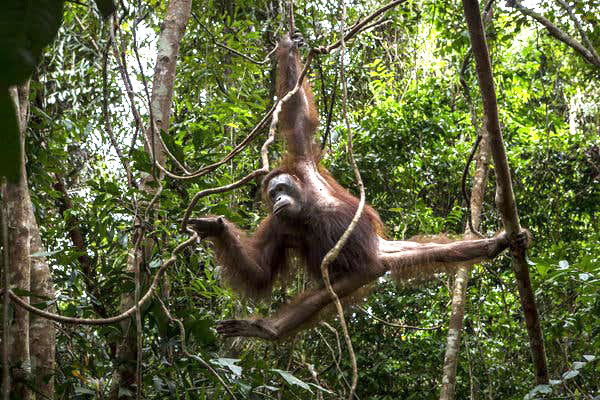
Around half of all orangutans living on the Southeast Asian island of Borneo — nearly 150,000 in all — vanished during a recent 16-year period. The causes included logging, land clearance for agriculture and mining that destroyed their habitats, according to a study in Current Biology released on Thursday.
www.nytimes.com/science/orangutans-endangered-species.htmlThe Asian nation is a hot spot of biological diversity, but local and international conservation groups are struggling to halt what amounts to animal genocide.
https://www.nytimes.com/travel/vietnam-wildlife-species-ecotravel-tourism.htmlThomas Edison once said, “I’d put my money on the sun and solar energy. What a source of power! I hope we don’t have to wait until oil and coal run out before we tackle that.”
The sun keeps rising and the costs keep falling! ...[T]he cost to produce one megawatt-hour of solar fell an incredible 86 percent between 2009 and 2017... solar in 2017 was less than half the price of coal the same year.
https://www.climaterealityproject.org/blog/fact-solar-energy-keeps-getting-more-affordableThe Northern Rockies are surely near the top of the list of the world’s most spectacular landscapes. Its ranges contain one of the last great expanses of biodiversity left in the continental United States, including most of the species that were there when Lewis and Clark first passed through in 1805 on their journey of discovery.
https://www.nytimes.com/opinion/northern-rockies-carole-king.html

























